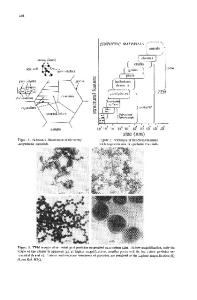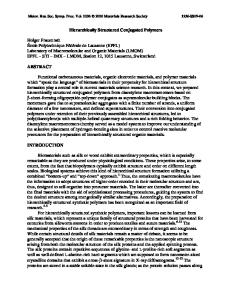Hierarchically Structured Materials Generated in Membrane Mimetic Systems: Nanosized Particle Production of Cds and ZnS
- PDF / 674,501 Bytes
- 12 Pages / 420.48 x 639 pts Page_size
- 74 Downloads / 257 Views
HIERARCHICALLY STRUCTURED MATERIALS GENERATED IN MEMBRANE MIMETIC SYSTEMS: NANOSIZED PARTICLE PRODUCTION OF CdS AND ZnS AT MONOLAYERS JANOS H. FENDLER Department of Chemistry, Syracuse University, Syracuse, New York 13244-4100 ABSTRACT The hierarchical evolution of the different mimetic systems and the concomitant level of control in the biomimetic mineralization will be critically discussed. MEMBRANE MIMETIC SYSTEMS Membrane-mimetic chemistry is a rapidly emerging discipline concerned with the development of processes which are inspired by the biological membrane. Surfactant aggregates - micelles, monolayers, organized multilayers (Langmuir-Blodgett films), bilayer lipid membranes (BLMs), vesicles, and polymerized vesicles - have been used as media in membrane-mimetic chemistry. Different aggregates formed from surfactants are illustrated in Figure 1. air
waner monoloyer
reversed micelle
S
6IMT.FMIN& 1W .W
spherical micelle
rod-like micelle
w/o microemulsion
o/w microemulsion
multicompartment vesicle
Figure 1. An oversimplified representation of organized aggregates formed from surfactants.
Mat. Res. Soc. Symp. Proc. Vol. 255. 01992 Materials Research Society
356
Monolayers (monomolecular layers) are formed by spreading naturally occurring lipids or synthetic surfactants, dissolved in a volatile solvent, over water in a Langmuir trough.2 The polar headgroups of the surfactants are in contact with water, the subphase, while their hydrocarbon tails protrude above it. Monolayers are characterized by surface area-surface pressure curves, surface potentials, and surface viscosities. In the gaseous state, surfactants float freely, mostly lying flat, on the surface without exerting much force on each other. Monolayers in their gaseous state may be expanded infinitely without any phase change. Compressing the gaseous monolayers results in a transition to a fluid state. At least two fluid subphases have been recognized. The initial transition on decreasing the surface area of gaseous monolayers results from a gradual reorganization of molecule to a position more or less perpendicular to the subphase surface. In this state, the average intermolecular distances are much greater than those in bulk liquids. On further compression, the distance between the surfactant headgroups decreases and the system assumes the liquid condensed fluid phase. In the solid phase, surfactants in the monolayer are packed as closely as possible; they all are perpendicular to the subphase or are tilted at an angle. Monolayers in their solid phase show low compressibility as indicated by the vertical surface pressure-surface area isotherm (Figure 2).
S40 >%
collapsed
:
solid (condensedl
%
~30 a.
20
fluid
I(liquid expanded,
o
"intermediat•
and liquid copdensed) 1
I0
%
0.0
--------------t-----
20 -
-.
30
\ -....
40
gaseou ,
----
S
100 200
Area (Z7/molecule) compression of barrier ----
Figure 2. Schematic representation of a surface pressure-surface area isotherm for monolayers. Ultimately, compression leads to
Data Loading...











